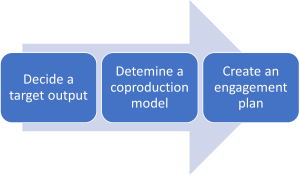I have been interested in how to co-produce content with communities for a long time. I know that there are many benefits of facilitating communities, as a space for conversation, mutual support, and learning, to name a few. For me there is something about producing collaborative content that takes it to another level.
My first explorations into co-production a couple of years ago were not very successful. I struggled to get out of the quagmire of the ‘how’ and ended up with very little to show for my time.
On reflection, I was perhaps too purist about the collaborative process, in terms of wanting all of the decision making to be collaborative. I also found it too difficult to marshal the right people to make it happen.
Working with existing projects
This year, I decided to try again. I put a call out to colleagues who were already working on content projects that they thought could be improved through community collaboration and together we formed a working group.
This approach allowed me to jump onto the coattails of work already happening, creating an opportunity for us to improve those projects and learn together. So, what have we learned?
Don’t expect every decision to be collaborative
It seems simple; ask the community what they want and then produce it together with them. We save time by working together instead of separately and everyone benefits.
In reality, if people have time to work collaboratively (and they often don’t think they do) they want to quickly know what it is they are working on and exactly what they need to do.
You’ll also likely have constraints about what is possible because of things like platform for publishing outputs, channels for engagement, and production standards you want to maintain.
This means that in the early-stage ideas development you’ll likely need to work with a small community group, or even on your own based on what you already know. This will enable you to share a clear vision and ask when reaching out to the wider community.
You’ll need lots and lots of structure
To be able to articulate opportunities for involvement and get people contributing quickly, structure is really important. We’ve been exploring different models for coproduction, and unpacking the structure needed to make those work.
Our approaches have included working with an editorial board, hosting a writing sprint, conducting interviews to write-up blog posts, asking for guest bloggers, collecting stories via workshops to share, and forming a small community sub-group to create outputs for the wider community.
There’s no magic formula, and each approach will have benefits and pit falls, but a common thread is to think systematically about the structure you create for people to get involved and how you will turn that into an output:
- How easy will it be for people to contribute?
- What involvement barriers might exist and how can you mitigate those?
- What value will each contribution give to the project output? How can we make it a coherent and engaging whole?
- How will the output be made available?
(One potential barrier to involvement is managing copyright, on which we were fortunate enough to get advice from John Kelly our inhouse copyright specialist.)
Find what will motivate individuals
Human energy is what makes these projects work. If you have people within the community who can be a driving force, you are onto a winner! You will need champions and to think carefully about why people will want to be involved.
Your engagement plan should consider different levels of involvement (by time / expertise/ effort) and clearly articulate the benefits and time commitment. You should also be sure to plan for moments that remind people of the end goal and that celebrate contributions along the way.
A framework for coproducing content
From what we have learnt so far, I have developed a simple planning framework for coproduction projects:
- Decide a target output – this should be as a result of a scoping exercise that considers audience needs and what else is available. You should also give thought to how your content will be hosted and what might be needed to make it accessible and sustainable.
- Determine a coproduction model – with practical steps you need to take to make it operational, such as stakeholder groups (with clear remit / terms of reference), submission process, events, partnerships, editorial oversight, draft timeline etc.
- Create an engagement plan – to include audience profile, channels, key messages and sample comms.

Tell your stories
Any blog about coproduction would be missing a trick if it didn’t also include a way to get involved.
Have you worked on a collaborative content project? What went well for you, and what would you do differently next time? I’d love to hear your stories and tips, and happy to share them here on the blog or build into the planning framework.
To share please contact me: Natasha Veenendaal
Photo by Jonny Gios on Unsplash


4 replies on “Collaborative content projects – what we’ve learned so far”
[…] See Natasha’s blog for more on managing collaborative content projects. […]
[…] See Natasha’s blog for more on managing collaborative content projects. […]
[…] See Natasha’s blog for more on managing collaborative content projects. […]
[…] See Natasha’s blog for more on managing collaborative content projects. […]